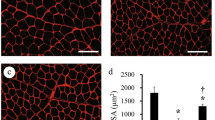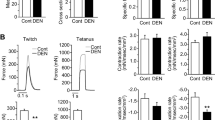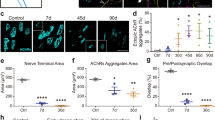Abstract
We determine the effects of direct electrical stimulation (ES) on the histological profiles in atrophied skeletal muscle fibers after denervation caused by nerve freezing. Direct ES was performed on the tibialis anterior (TA) muscle after denervation in 7-week-old rats divided into groups as follows: control (CON), denervation (DN), or denervation with direct ES (subdivided into a 4 mA (ES4), an 8 mA (ES8), or a 16 mA stimulus (ES16). The stimulation frequency was set at 10 Hz, and the voltage was set at 40 V (30 min/day, 6 days/week, for 3 weeks). Ultrastructural profiles of the membrane systems involved in excitation–contraction coupling, and four kinds of mRNA expression profiles were evaluated. Morphological disruptions occurred in transverse (t)-tubule networks following denervation: an apparent disruption of the transverse networks, and an increase in the longitudinal t-tubules spanning the gap between the two transverse networks, with the appearance of pentads and heptads. These membrane disruptions seemed to be ameliorated by relatively low intensity ES (4 mA and 8 mA), and the area of longitudinally oriented t-tubules and the number of pentads and heptads decreased significantly (P < 0.01) in ES4 and ES8 compared to the DN. The highest intensity (16 mA) did not improve the disruption of membrane systems. There were no significant differences in the α1sDHPR and RyR1 mRNA expression among CON, DN, and all ES groups. After 3 weeks of denervation all nerve terminals had disappeared from the neuromuscular junctions (NMJs) in the CON and ES16 groups. However, in the ES4 and ES8 groups, modified nerve terminals were seen in the NMJs. The relatively low-intensity ES ameliorates disruption of membrane system architecture in denervated skeletal muscle fibers, but that it is necessary to select the optimal stimulus intensities to preserve the structural integrity of denervated muscle fibers.





Similar content being viewed by others
References
Adams GR (2002) Exercise effects on muscle insulin signaling and action invited review: autocrine and/or paracrine insulin-like growth factor-I activity in skeletal muscle. J Appl Physiol 93:1159–1167
Ashley Z, Salmons S, Boncompagni S, Protasi F, Russold M, Lanmuller H, Mayr W, Sutherland H, Jarvis JC (2007a) Effects of chronic electrical stimulation on long-term denervated muscles of the rabbit hind limb. J Muscle Res Cell Motil 28:203–217
Ashley Z, Sutherland H, Lanmüller H, Russold MF, Unger E, Bijak M, Mayr W, Boncompagni S, Protasi F, Salmons S, Jarvis JC (2007b) Atrophy, but not necrosis, in rabbit skeletal muscle denervated for periods up to one year. Am J Physiol Cell Physiol 292:C440–C451
Bodine SC, Stitt TN, Gonzalez M, Kline WO, Stover GL, Bauerlein R, Zlotchenko E, Scrimgeour A, Lawrence JC, Glass DJ, Yancopoulos GD (2001) Akt/mTOR pathway is a crucial regulator of skeletal muscle hypertrophy and can prevent muscle atrophy in vivo. Nat Cell Biol 3:1014–1019
Brenner HR, Rudin W (1989) On the effect of muscle activity on the end-plate membrane in denervated mouse muscle. J Physiol 410:501–512
Brown MC, Holland RL (1979) A central role for denervated tissues in causing nerve sprouting. Nature 282:724–726
Dow DE, Cederna PS, Hassett CA, Kostrominova TY, Faulkner JA, Dennis RG (2004) Number of contractions to maintain mass and force of a denervated rat muscle. Muscle Nerve 30:77–86
Dulhunty AF (1984) Heterogeneity of T-tubule geometry in vertebrate skeletal muscle fibres. J Muscle Res Cell Motil 5:333–347
Dulhunty AF, Gage PW (1985) Excitation—contraction coupling and charge movement in denervated rat extensor digitorum longus and soleus muscles. J Physiol 358:75–89
Dulhunty AF, Gage PW, Alois AA (1984) Indentation in the terminal cisternae of denervated rat EDL and soleus muscle fibers. J Ultrastruct Res 88:30–43
Eisenberg BE (1983) Quantitative ultrastructure of mammalian skeletal muscle. In: Peachey LD (ed) Handbook of physiology, section 10, skeletal muscle. American Physiological Society, Bethesda, pp 73–112
Eisenberg BR, Salmons S (1981) The reorganization of subcellular structure in muscle undergoing fast-to-slow type transformation: a stereological study. Cell Tissue Res 220:449–471
Eisenberg BR, Brown JM, Salmons S (1984) Restoration of fast muscle characteristics following cessation of chronic stimulation. The ultrastructure of slow-to-fast transformation. Cell Tissue Res 238:221–230
Engel AG (1994) Quantitative morphological studies of muscle. In: Engel AG, Franzini-Armstrong C (eds) Myology, vol 1, 2nd edn. McGraw-Hill, New York, pp 1018–1045
Engel AG, Stonnington HH (1974) Morphological effects of denervation of muscle. A quantitative ultrastructural study. Ann N Y Acad Sci 228:68–88
Finol HJ, Lewis DM, Owens R (1981) The effects of denervation on contractile properties or rat skeletal muscle. J Physiol 319:81–92
Forbes MS, Plantholt BA, Sperelakins N (1977) Cytochemical staining procedures selective for sarcotubular systems of muscle: modification and applications. J Ultrastruct Res 60:306–327
Franzini-Armstrong C (1991) Simultaneous maturation of transverse tubules and sarcoplasmic reticulum during muscle differentiation in the mouse. Dev Biol 146:353–363
Glass DJ (2003) Molecular mechanisms modulating muscle mass. Trends Mol Med 9:344–350
Herbison GJ, Jaweed MM, Ditunno JF Jr (1983) Acetylcholine sensitivity and fibrillation potentials in electrically stimulated crush-denervated rat skeletal muscle. Arch Phys Med Rehabil 64:217–220
Ishii DN (1989) Relationship of insulin-like growth factor II gene expression in muscle to synaptogenesis. Proc Natl Acad Sci USA 86:2898–2902
Kern H, Boncompagni S, Rossini K, Mayr W, Fanò G, Zanin ME, Podhorska-Okolow M, Protasi F, Carraro U (2004) Long-term denervation in humans causes degeneration of both contractile and excitation-contraction coupling apparatus, which is reversible by functional electrical stimulation (FES): a role for myofiber regeneration? J Neuropathol Exp Neurol 63:919–931
Kostrominova TY, Dow DE, Dennis RG, Miller RA, Faulkner JA (2005) Comparison of gene expression of 2-mo denervated, 2-mo stimulated-denervated, and control rat skeletal muscles. Physiol Genomics 22:227–243
Lømo T, Slater CR (1978) Control of acetylcholine sensitivity and synapse formation by muscle activity. J Physiol 275:391–402
Love FM, Son YJ, Thompson WJ (2003) Activity alters muscle reinnervation and terminal sprouting by reducing the number of Schwann cell pathways that grow to link synaptic sites. J Neurobiol 54:566–576
McKoy G, Ashley W, Mander J, Yang SY, Williams N, Russell B, Goldspink G (1999) Expression of insulin growth factor-1 splice variants and structural genes in rabbit skeletal muscle induced by stretch and stimulation. J Physiol 516:583–592
Midrio M (2006) The denervated muscle: facts and hypotheses. A historical review. Eur J Appl Physiol 98:1–21
Mobly BA, Eisenberg BR (1975) Sizes of components in frog skeletal muscle measured by methods of stereology. J Gen Physiol 66:31–45
Nicolaidis SC, Williams HB (2001) Muscle preservation using an implantable electrical system after nerve injury and repair. Microsurgery 21:241–247
Nishizawa T, Yamashia S, McGrath KF, Tamaki H, Kasuga N, Takekura H (2006) Plasticity of neuromuscular junction architectures in rat slow and fast muscle fibers following temporary denervation and reinnervation processes. J Muscle Res Cell Motil 27:607–615
Pachter BR, Eberstein A (1983) Endplate postsynaptic structure dependent upon muscle activity. Neurosci Lett 43:277–283
Pellegrino C, Franzini-Armstrong C (1969) Recent contribution of electron microscope to the study of normal and pathological muscle. In: Richter GW, Epstein MA (eds) International review of experimental pathology. Academic Press, New York, pp 139–226
Péréon Y, Sorrentino V, Dettbarn C, Noirecaud J, Palade P (1997) Dihydropyridine receptor and ryanodine receptor gene expression in long-term denervated rat muscles. Biochem Biophys Res Commu 240:612–617
Sakakima H, Kawamata S, Kai S, Ozawa J, Matsuura N (2000) Effects of short-term denervation and subsequent reinnervation on motor endplates and the soleus muscle in the rat. Arch Histol Cytol 63:495–506
Schmalbruch H, Al-Amood WS, Lewis DM (1991) Morphology of long-term denervated rat soleus muscle and the effect of chronic electrical stimulation. J Physiol 441:233–241
Schmid A, Renaud J-F, Fosset M, Meanx J-P, Lazdunski M (1984) The nitrendipine-sensitive Ca2+ channel in chick muscle cells and its appearance during myogenesis in vitro and in vivo. J Biol Chem 259:11366–11372
Sommer JR, Wauch RA (1976) The ultrastructure of the mammalian cardiac muscle cell with special emphasis on tubular membrane system. Am J Pathol 82:192–232
Takekura H, Kasuga N (1999) Differential response of the membrane systems involved in excitation–contraction coupling to early and later postnatal denervation in rat skeletal muscle. J Muscle Res Cell Motil 20:279–289
Takekura H, Kasuga N, Kitada K, Yoshioka T (1996) Morphological changes in the triads and sarcoplasmic reticulum of rat slow and fast muscle fibres following denervation and immobilization. J Muscle Res Cell Motil 17:391–400
Takekura H, Fujinami N, Nishizawa T, Ogasawara H, Kasuga N (2001) Eccentric exercise-induced morphological changes in the membrane systems involved in excitation–contraction coupling in rat skeletal muscle. J Physiol 533:571–583
Takekura H, Tamaki H, Nishizawa T, Kasuga N (2003) Plasticity of the transverse tubules following denervation and subsequent reinnervation in rat slow and fast muscle fibres. J Muscle Res Cell Motil 24:439–451
Yamashita S, McGrath KF, Yuki A, Tamaki H, Kasuga N, Takekura H (2007) Assembly of transverse tubule architecture in the middle and myotendinous junctional regions in developing rat skeletal muscle fibers. J Muscle Res Cell Motil 28:141–151
Acknowledgments
This work was supported in part by a Grant-in-Aid for Young Scientists (B) (project no. 19700444 to K. Tomori) and Grant-in-Aid for Scientific Research (B, project no. 20300217 to H. Takekura) from the Japan Society for the Promotion of Science in 2008–2011, and a Grant-in-Aid for Scientific Research from the National Institute of Fitness and Sports (President’s Discretionary Budget 2009 to H. Takekura).
Author information
Authors and Affiliations
Corresponding author
Rights and permissions
About this article
Cite this article
Tomori, K., Ohta, Y., Nishizawa, T. et al. Low-intensity electrical stimulation ameliorates disruption of transverse tubules and neuromuscular junctional architecture in denervated rat skeletal muscle fibers. J Muscle Res Cell Motil 31, 195–205 (2010). https://doi.org/10.1007/s10974-010-9223-8
Received:
Accepted:
Published:
Issue Date:
DOI: https://doi.org/10.1007/s10974-010-9223-8




